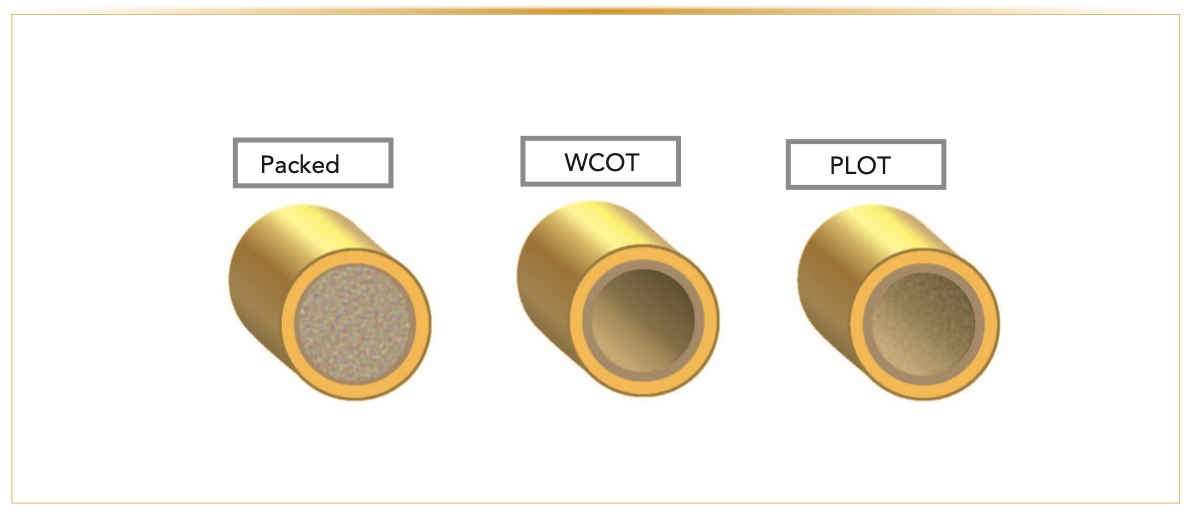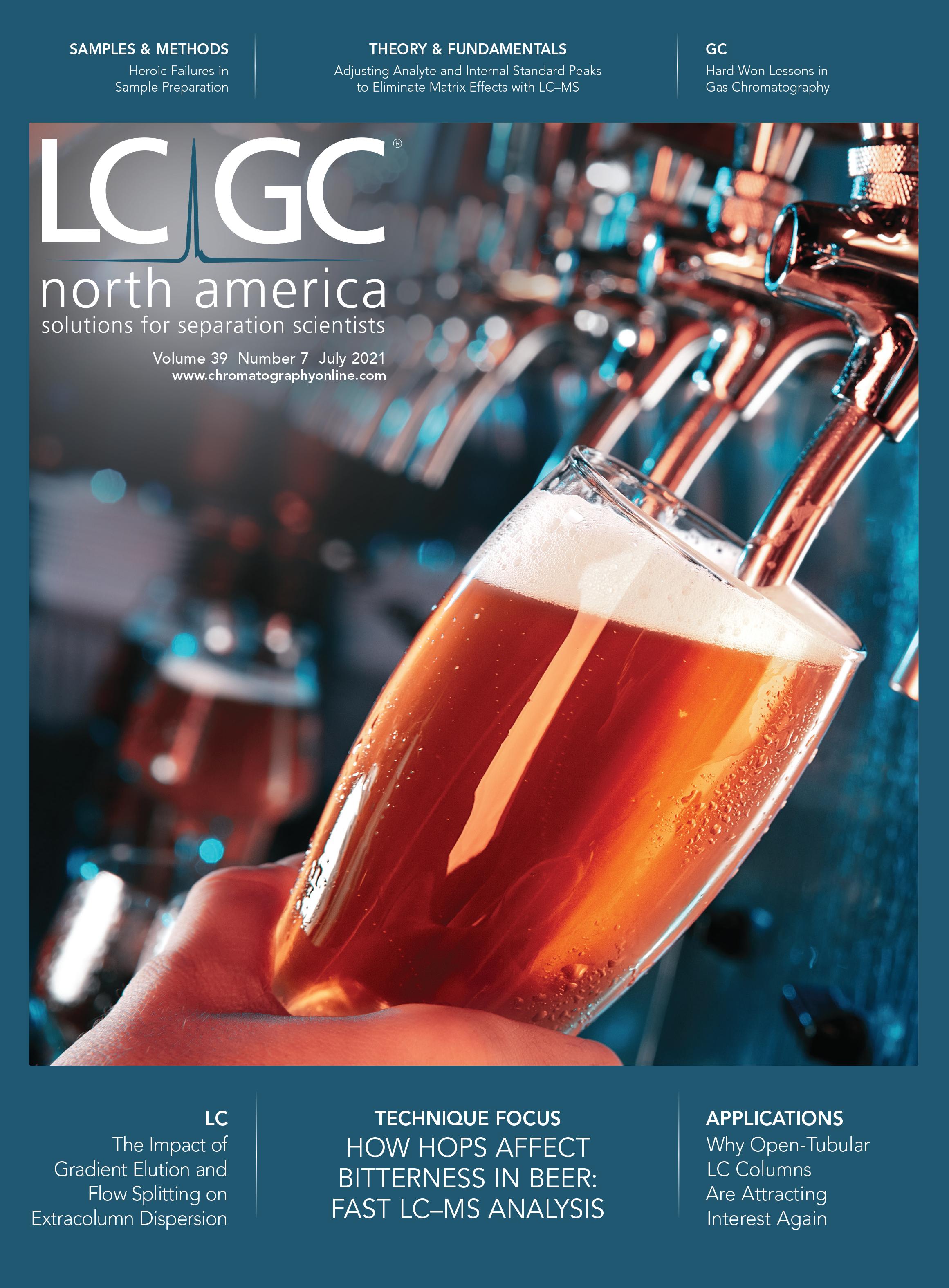Recent Developments in Open-Tubular Liquid Chromatography Columns
Liquid chromatography (LC) has traditionally been practiced using columns that are fully packed with discrete particles, or constructed around monolithic structures. The concept of open-tubular (OP) columns, or narrow internal diameter columns with a thin coating of stationary phase, has been known for many years. Limitations in sample capacity, column reproducibility, and instrumentation have hindered a broader adoption of the technique. However, recent developments in instrumentation, fabrication, nanoparticle technology, and other novel stationary phase supports have reignited activity in this area. Interest in open-tubular liquid chromatography (OTLC) stems from the potential for high efficiency, low back pressure, and the promise of more environmentally sustainable separations. This article explores recent developments in OTLC, with an emphasis on advances in column technology.
Liquid chromatography (LC) is typically practiced using columns packed with discrete particles or using monolithic structures. Open-tubular liquid chromatography (OTLC) describes the use of an open capillary tube, where the stationary phase is coated as a thin layer along the wall.
The concept of open-tubular chromatography originated in the realm of gas chromatography (GC), where Golay predicted in 1958 that a capillary tube coated with a thin layer of stationary phase could produce highly efficient separations (1,2). This discovery would transform GC from packed columns that formerly dominated the laboratory environment to open-tubular formats that prevail today. According to Forster and associates, Tsuda is credited with initially transferring the concept of open-tubular column chromatography to LC (3). OTLC is now known as a viable option in liquid chromatography, as well as in capillary electrochromatography (CEC).
OTLC was initially of interest because the technique could provide highly efficient separations for complex mixtures, utilized small sample volumes, consumed comparatively little mobile phase, and operated at relatively low back pressures. Unfortunately, the advantages of OTLC were negated by poor sample capacity, as well as difficulties in column manufacturing and reproducibility. Additionally, instrumentation that could provide consistent low-flow control, small-volume manipulation, and detector sensitivity were lacking on existing platforms.
Several recent reviews on OTLC suggest that there may be an emerging trend toward renewed interest in this technique. The demands on column technology continue to grow, fueled by sample complexity and limited volumes, particularly in challenging biological applications in proteomics and metabolomics, among other scientific studies. This is coupled with enabling technologies in microfabrication, advances in instrument design, miniaturization, and improved detector sensitivity, improving the efficacy of OTLC. This paper is intended to collect and distill the current trends on OTLC, focusing on new column developments, motivations, and supporting technologies.
OTLC Column Types and Preparation
OTLC columns have been classified as either wall-coated open-tubular (WCOT) or porous-layer open-tubular (PLOT) (4). WCOT columns are characterized by a thin, non-porous coating of high molecular weight polymers (for example, polydimethylsiloxane [PDMS]). The PDMS polymers may be modified with functional groups, such as cyano and phenyl, to alter polarity and selectivity. Polyethylene glycol (PEG) and ionic liquids (ILs) may also be used to produce WCOT columns (4).
PLOT columns, by contrast, contain a thin layer of porous material along the walls of the capillary. The porous material may be in the form of organic polymers (such as polystyrene), or inorganic materials (such as silica, among many others). Because of the higher sample capacity of PLOT columns, these have generally been of greater interest in LC, whereas WCOT columns continue to dominate in GC, as a result of their high efficiency and relative ease of manufacture. A representation of the open-tubular column formats, as well as their packed and monolithic counterparts, is presented in Figure 1.
FIGURE 1: Pictorial representation of different types of capillary columns. Figure based on conceptualization in (12).

WCOT Columns
Although WCOT LC columns suffer from low sample capacity and preparation difficulties (especially columns with small internal diameters), there have been some recent developments that have sparked interest. To address the issue of analyte loadability, Liu and Yang proposed that, at very small diameters, the issue of low sample capacity diminishes because of a lack of dilution effects (5). The group demonstrated that a dense, nonporous coating could be achieved through the use of highly concentrated solutions of octadecyltrimethoxysilane (OTMS) during the coating process, yielding high-efficiency columns. The authors did note, however, that uncertainty in the absolute capillary i.d. may be an issue that impedes broad acceptance of the technology.
PLOT Columns
Organic polymer PLOT columns provide advantages of increased stability over a wide range of pH values as compared to their inorganic counterparts, and are often considered easier to prepare (1). Organic coatings, however, are subject to swelling and shrinking in the presence of organic solvents, and thus may provide less reproducible results or overall lifetimes than inorganic-based PLOT columns.
A common technique for the preparation of organic PLOT columns is in situ thermally initiated radical polymerization. In general, fused silica capillaries are first activated by treatment with a base, thereby generating silanols on the surface for anchoring. Following neutralization and drying of the capillary, a silanizing agent, such as 3-(trimethoxysilyl)propyl methacrylate, is introduced to bond with the surface and act as a bridge to the forthcoming polymer. Next, a mixture of monomer, cross-linker, porogen and thermal initiator are pumped into the column, and the ends of the column are sealed. Heating the column initiates the polymerization, and finally, after a given time, the column can be rinsed and utilized. Polymers of styrene, divinylbenzene, and various acrylates and methacrylates are common. Obviously, the reaction conditions at each of the step, choices of reagents, and manufacturing technique will all impact the final column. It is also possible to further modify polymeric coatings to alter retention and selectivity of the column.
For inorganic PLOT column preparation, the sol-gel method is generally utilized. Again, the initial step is to treat the capillary and generate surface silanols. Silicon alkoxides, such as tetraethoxysilane (TEOS), are then hydrolyzed and condensed into a gel within the column, using acid or base to catalyze the reaction. Subsequent aging and drying yields a porous silica that can then be further reacted with various functional groups in a manner similar to the modification of silica particles in packed LC. As with the organic porous polymer coating preparation, the conditions at each step, along with the reagents chosen, highly impact the resultant column and its characteristics.
Hara and associates have explored the development of silica-based PLOT columns using tetramethoxysilane (TMOS) as a silica precursor (6). In a recent study, the group investigated the use of a mixture of TMOS and methyltrimethoxysilane (MTMS) to produce what they termed a hybrid PLOT columns with an internal diameter of 5 μm (7). The term hybrid is meant to describe the incorporation of organic moieties into the silica structure of the porous material. Addition of more methyl groups via MTMS resulted in coatings that were more hydrophobic, and thus more retentive than using TMOS alone. This also has the implication that a thinner coating of the hybrid material could provide the same retention as a thicker TMOS-based coating with improved efficiency. The group noted that the layer thickness could be controlled in a linear fashion with the amount of TMOS/MTMS in the sol-gel mixture, and up to column lengths up to 1.3 m were successfully prepared. One noted limitation of the process was that the high viscosity of the sol-gel solution makes filling the capillaries of longer length difficult.
The investigation of new classes of separation media such a metal organic frameworks (MOFs) in chromatography is also of interest to PLOT column development. One example of incorporating MOFs into OTLC was published by Zhu and associates (8). In this work, the researchers added isoreticular metal organic framework-3 (IRMOF-3) particles to poly[2-(methacryloyloxy) ethyl] dimethyl-(3-sulfopropyl) ammonium hydroxide polymer in an open- tubular format. In addition, the MOF was derivatized with vancomycin. Both the modified and unmodified version were compared for chromatographic performance against the base polymer. The vancomycin-modified MOF system was shown to provide retention and separation for a set of neutral, acidic, and basic analytes, and exhibited a number of different retention mechanisms.
Current Drivers and Enabling Technologies
Complex and Limited Samples
Some of the recent reviews on OTLC credit the Karger group for the resurgence of interest in the technique (1,4). In one interesting paper, the Karger group tackled the comprehensive analysis of N-linked glycans released from ovalbumin using a 10 μm ID PLOT column in hydrophilic-interaction chromatography (HILIC) mode coupled to mass spectrometry (MS) (9). The PLOT column consisted of an ethylenediamine-modified poly(vinylbenzyl chloride-divinylbenzene) coating. In another example, the Karger group used a polystyrene/divinylbenzene 10 μm PLOT column coupled to MS for the analysis of protein digests initially sampled using laser capture microdissection (LCM) (10). According to the authors, LCM allows for the isolation of biologically distinct cell subtypes; however obtaining large sample sizes is laborious. Careful sample workup, in addition to a highly sensitive PLOT LC–MS/MS system, allowed the group to identity increased numbers of proteins. These examples highlight a couple of drivers—the need for highly efficient separations to deal with complex samples, and the ability to analyze precious or highly limited sample sizes. The examples also note one on the major OTLC enabling technologies—mass spectrometry.
Instrumentation
The very small column volumes associated with OTLC columns leads to heavy demands on the instrumentation around it. Although it was known early that the technique would provide highly efficient chromatography, common detectors lacked the sensitivity for such small volumes and microsampling; additionally, nanoflow techniques and instrumentation were uncommon. The detection sensitivity issue has been largely solved with the development of highly sensitive MS systems and electrospray ionization (ESI) interfaces. The direct coupling of OTLC and ESI–MS minimizes band broadening, and the flow rates are often optimal for both chromatographic efficiency and ionization efficiency. Microsampling devices, often integrated, and nanoflow instrumentation improvements continue to further enable techniques like OTLC.
Two recent reviews on trends in miniaturization of instrumentation make note of the column as a vital part of the equation to reduce instrumental footprint (11,12). The promise of OTLC columns for high efficiency, low back pressure, low mobile-phase volume, and direct MS coupling is highlighted in both; however, the lack of commercially available columns and instrumentation is a commonly stated limiting factor for broad acceptance.
Conclusions and Outlook
There is still significant and renewed interest in open-tubular liquid chromatography. This interest has largely been stimulated by the need to analyze complex samples, conserve material where sample sizes are limited, and basic material science and process research, as well as ambitions to achieve environmentally friendly separations. Technology developments in instrumentation (such as improved low-flow control, innovative micro- and nano-sampling devices, and especially mass spectrometry) have continued to enable advances in OTLC. Column technology, as highlighted in this work, also continues to develop in terms of preparation processing and device design, as well as in the fundamental understanding of separation media most appropriate for this format.
What seems to be lacking for a broader acceptance and usage of the OTLC technology is a complete, synergistic system incorporating sampling, delivery, separation, and detection (as well as data analysis). As noted by Røberg-Larsen and associates, liquid chromatography is a key component in single-cell analysis, a complex and limited sample class of high interest (13). The authors go on to note that there are some commercial tools available (for example, packed nano LC columns) for such efforts, but alternative formats such as OTLC, among others, have great potential to further advance single-cell ‘omics analysis.
References
(1) R.-N. Li et al., Chinese J. Anal. Chem. 45(12), 1865–1873 (2017).
(2) P. Xiang et al., Trends Analyt. Chem. 142, 116321 (2021).
(3) S. Forster, H. Kolmar, and S. Altmaier, J. Chromatogr. A 1283, 110–115 (2013).
(4) D.A. Vargas Medina et al., J. Chromatogr. A 1641, 461989 (2021).
(5) Y. Yang and S. Liu, Talanta 1, 100003 (2020).
(6) T. Hara et al., J. Chromatogr. A 1552, 87–91 (2018).
(7) T. Hara et al., J. Chromatogr. A 1580, 63–71 (2018).
(8) M. Zhu et al., Talanta 184, 29–34 (2018).
(9) Q. Luo et al., J. Chromatogr. A 1216(8), 1223–1231 (2009).
(10) D. Thakur et al., J. Chromatogr. A 1218(45), 8168–8174 (2011).
(11) E. Vasconcelos Soares Maciel et al., Anal. Chim. Acta 1103, 11–31 (2020).
(12) Mejía-Carmona et al., Trends Analyt. Chem. 122, 115735 (2020).
(13) H. Røberg-Larsen et al., Anal. Chim. Acta (2021).
David S. Bell is a director of Research and Development at Restek. He also serves on the Editorial Advisory Board for LCGC and is the Editor for “Column Watch.” Over the past 20 years, he has worked directly in the chromatography industry, focusing his efforts on the design, development, and application of chromatographic stationary phases to advance gas chromatography, liquid chromatography, and related hyphenated techniques. His main objectives have been to create and promote novel separation technologies and to conduct research on molecular interactions that contribute to retention and selectivity in an array of chromatographic processes. His research results have been presented in symposia worldwide, and have resulted in numerous peer-reviewed journal and trade magazine articles. Direct correspondence to: LCGCedit@mmhgroup.com


Extracting Estrogenic Hormones Using Rotating Disk and Modified Clays
April 14th 2025University of Caldas and University of Chile researchers extracted estrogenic hormones from wastewater samples using rotating disk sorption extraction. After extraction, the concentrated analytes were measured using liquid chromatography coupled with photodiode array detection (HPLC-PDA).
Polysorbate Quantification and Degradation Analysis via LC and Charged Aerosol Detection
April 9th 2025Scientists from ThermoFisher Scientific published a review article in the Journal of Chromatography A that provided an overview of HPLC analysis using charged aerosol detection can help with polysorbate quantification.
Removing Double-Stranded RNA Impurities Using Chromatography
April 8th 2025Researchers from Agency for Science, Technology and Research in Singapore recently published a review article exploring how chromatography can be used to remove double-stranded RNA impurities during mRNA therapeutics production.










